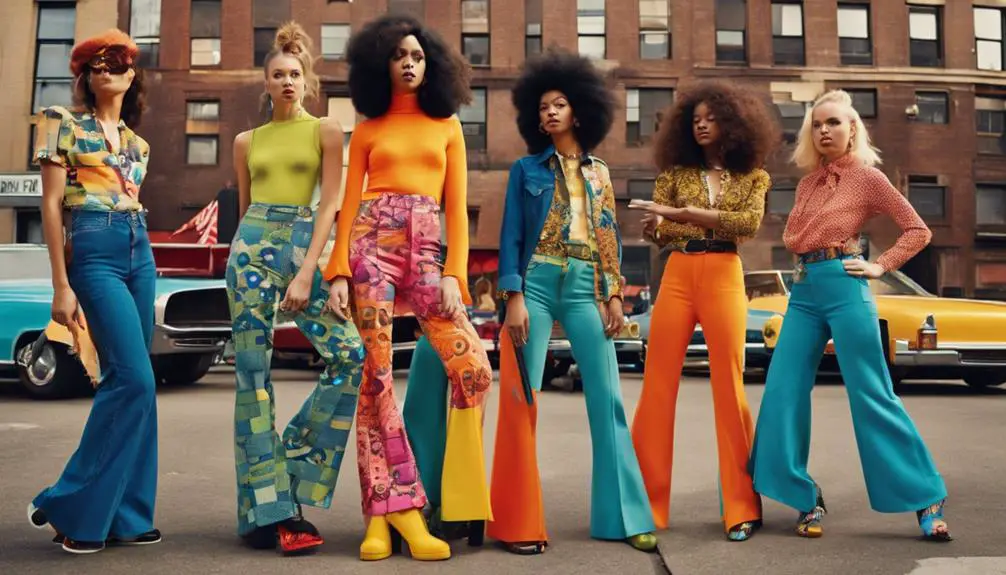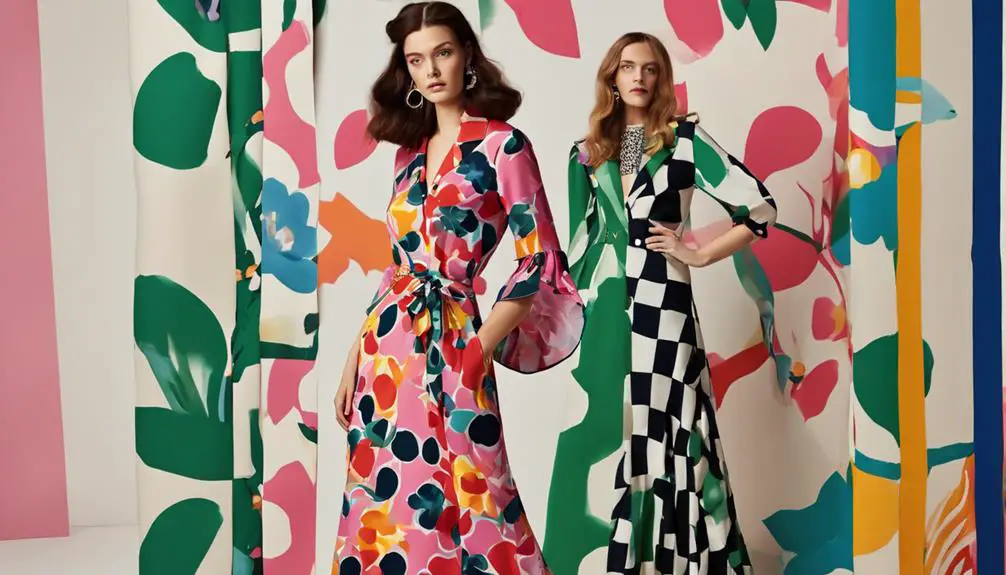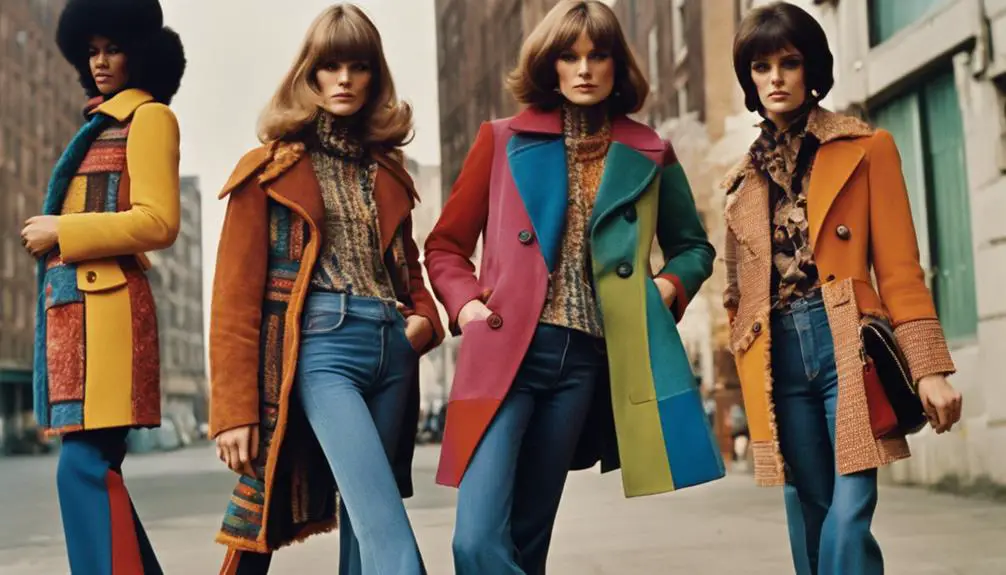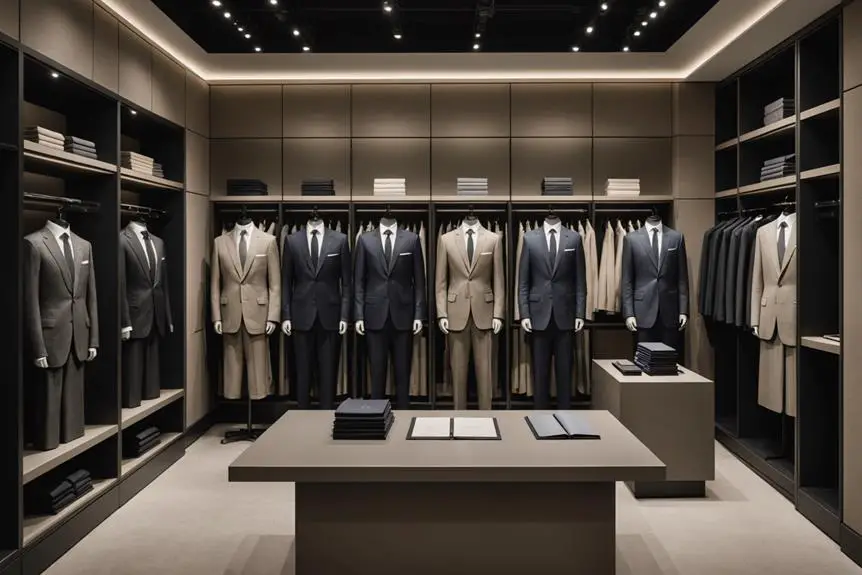The 1970s boasted iconic fashion pieces that still resonate today. You can't miss the legendary bell bottoms, fitted at the top and flaring at the bottom, capturing the era's vibrant spirit. High-waisted jeans and hot pants were popular for their bold style choices. Wrap dresses by Diane Von Furstenberg represented women's empowerment, while platform shoes added flair to any outfit. Accessorizing with floppy hats and chunky jewelry brought individuality to the forefront. With vibrant colors and unique prints defining the decade, you'll soon discover more about this fascinating fashion era and its lasting impact.
Iconic Pant Styles

When you think of iconic pant styles from the 1970s, five key trends immediately come to mind. First up, bell bottoms. These pants, fitted at the top and flared at the bottom, represented the vibrant party culture of the decade. Pairing them with platform heels gave you that extra height and flair, making you stand out on the dance floor.
The evolution of fashion accessories, like men's belts, also complemented these styles, adding an essential touch to outfits. Then there are high-waisted jeans, which accentuated the waist and elongated the legs. This style often found its place alongside crop tops or tucked-in shirts, and luckily, they've made a comeback in recent years.
Next, let's talk about hot pants. These extremely short shorts sparked debates about modesty, becoming a bold fashion statement during summer parties. If you wanted a more laid-back option, corduroy pants offered warmth and comfort, perfect for those casual everyday looks. Their unique ribbed texture made them a staple for many.
Lastly, the military look emerged as a response to societal influences like the Vietnam War. Think khaki and olive green tones, featuring fatigue jackets and cargo pants. This style emphasized practicality while still being fashionable.
Vibrant Prints and Patterns
The 1970s were all about bold prints and patterns that captured the decade's eclectic spirit. You couldn't walk down the street without noticing vibrant prints splashed across clothing, showcasing bold colors and unique motifs. This era embraced self-expression, and tie-dye emerged as a hallmark of the 1970s counterculture, with many fashion enthusiasts often seeking out vintage clothing options to reflect this style.
Originally a DIY craft, designers like Halston elevated tie-dye into a high-fashion statement, making it a staple for casual wear and festival attire. As you explore the world of vintage clothing, identifying vintage pieces becomes essential in appreciating the authenticity of the fashion from this era.
The influence of the hippie movement also played a significant role in popularizing ethnic and folk-inspired prints. These designs celebrated cultural heritage, adding depth and diversity to the fashion landscape. You'd often see flowing dresses and tops adorned with intricate patterns that told stories of far-off places.
Chevron patterns, characterized by their bold zigzag designs, became another significant trend during this period. These eye-catching shapes appeared not only on clothing but also in home decor, turning living spaces into vibrant reflections of the times. Fashion designers creatively merged these elements, resulting in clothing that was as much a form of art as it was a means of dressing.
In the 1970s, wearing vibrant prints and patterns wasn't just about style; it was a way to express individuality and embrace the freedom of the decade. Whether you were donning a tie-dye shirt or a chevron-patterned maxi dress, you were making a statement that resonated with the spirit of the times.
Statement Dresses and Suits

Statement dresses and suits defined the 1970s fashion landscape, showcasing a blend of empowerment and individuality. One of the most iconic pieces from this era is the wrap dress, designed by Diane Von Furstenberg. This versatile silhouette flattered various body types and became a symbol of women's empowerment, allowing you to express your style with confidence.
The ability to tailor pieces for the perfect fit was also significant, as many women sought to guarantee their outfits reflected their unique style and comfort, emphasizing the importance of assessing jacket fit.
Yves Saint Laurent's Le Smoking tuxedo also made waves, revolutionizing women's evening wear by merging masculine tailoring with feminine elegance. This daring suit let women step into traditionally male-dominated spaces, embodying power and individuality.
Kaftan dresses, with their vibrant prints and loose silhouettes, captured the relaxed bohemian spirit of the decade. Celebrities like Elizabeth Taylor donned these flowing garments, making them a staple for both casual outings and glamorous events.
Then there were Gunne Sax dresses, known for their Victorian-inspired designs and intricate detailing. These romantic pieces appealed to many during the era, perfect for both casual gatherings and formal occasions.
Bianca Jagger's bold fashion choices epitomized Studio 54 glamor, particularly her iconic lamé halter-top dress. This moment in fashion not only reflected personal style but also influenced the nightlife scene.
Whether you gravitated towards classic black satin slips or vibrant statement dresses, the 1970s offered a plethora of options that celebrated women's empowerment and individual expression through fashion.
Defining Accessories
Accessories played an essential role in defining 1970s fashion, complementing the bold statement dresses and suits that characterized the era. You couldn't walk down the street without spotting someone sporting aviator glasses, which became a symbol of coolness and laid-back attitude, often seen on icons like Gloria Steinem.
These shades perfectly matched the oversized collars that adorned jackets and blouses, adding a touch of disco glamour to even the most conservative outfits.
Hot pants and short shorts made headlines, representing women's sexual liberation and sparking debates about modesty. Pairing these daring pieces with floppy hats created a bohemian vibe, reminiscent of the late 60s hippie culture.
Floppy hats often accompanied flowing kaftans and floral dresses, completing the carefree look.
Jewelry also played a significant role in defining the decade's style. Puka shell jewelry and love beads captured the essence of the era, symbolizing beachy vibes and the peace and love movements.
You'd see these accessories worn with casual outfits, making them essential for any fashion-forward individual.
Bright colors were everywhere, adding vibrancy to everyday wear. Think about how a disco ball reflects light—1970s fashion was all about that sparkle and energy.
Layering accessories, like leather jackets over a bold outfit, made bold statements. Each piece, whether it was a chunky necklace or a statement belt, contributed to a unique personal style and told a story about who you were during this unforgettable decade.
Influential Outerwear and Footwear

What defined the 1970s more than its striking outerwear and footwear? This decade brought us bold fashion statements that continue to influence style today.
From the rebellious spirit of punk to the relaxed bohemian vibe, outerwear and footwear played a pivotal role in shaping the era's aesthetic. The era also saw an evolution in clothing materials and designs, much like how Harley Davidson clothing has evolved while maintaining its core essence and community spirit, as seen in their vintage clothing identification.
Here are four iconic pieces that captured the essence of 1970s fashion:
- Leather Moto Jackets: As symbols of counter-culture, these jackets paired perfectly with graphic tees and bell-bottoms, reflecting an anti-establishment attitude.
- Over-the-Knee Boots: Crafted from suede or leather, these boots became a staple for women, often worn with mini dresses and casual outfits that embraced the bohemian vibe.
- Shearling Coats: With their oversized designs and luxurious materials, shearling coats offered both warmth and style. You could see them in movies like "Almost Famous," showcasing their timeless appeal.
- Platform Shoes and Clogs: Both footwear styles provided height and comfort. Platform shoes became essential for any disco era outfit, while clogs, with their wood-soled designs, complemented flowing dresses, adding to the laid-back aesthetic of the decade.
Together, these pieces not only defined the fashion landscape of the 1970s but also laid the groundwork for future trends. Embracing these styles allows you to channel the spirit of a vibrant and transformative era.




Good stuff Thank you.
homepage
Thanks a lot, An abundance of info!
casino en ligne
You stated it wonderfully!
casino en ligne
You actually explained it well.
casino en ligne
You actually mentioned this perfectly.
casino en ligne
Position clearly utilized!.
casino en ligne
You said it perfectly..
casino en ligne
Awesome facts, Regards.
casino en ligne
Very good info, Thanks a lot!
casino en ligne
You mentioned it adequately.
casino en ligne